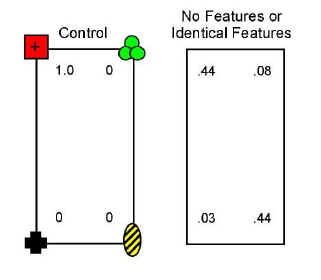Cheng
& Spetch Homepage
Next Section:
Pigeons average cues from
different landmark
__________
|
II. The Geometric Module
Performance on the task
In a working-memory task, rats were presented with a goal location
somewhere in a rectangular enclosure (Cheng,
1986; Margules & Gallistel,
1988). They had to find the goal again at the same location after a short
delay. The goal's location changed from day to day. The arena had many possible disambiguating cues, including different
visual patterns in the corners, different colors of walls, different odors,
and different textures at the corners. Nevertheless, rats frequently made rotational errors, searching at
a position rotated 180 degrees from the goal through the center of the
arena. In a reference memory task, in which the goal location did not change
across days, the rats learned to choose the correct location more than
the rotational error. Similar rotational errors have also been found in human children 18-24 months
of age. (Hermer & Spelke, 1994, 1996) (Cheng,
1986; Margules & Gallistel,
1988). They had to find the goal again at the same location after a short
delay. The goal's location changed from day to day. The arena had many possible disambiguating cues, including different
visual patterns in the corners, different colors of walls, different odors,
and different textures at the corners. Nevertheless, rats frequently made rotational errors, searching at
a position rotated 180 degrees from the goal through the center of the
arena. In a reference memory task, in which the goal location did not change
across days, the rats learned to choose the correct location more than
the rotational error. Similar rotational errors have also been found in human children 18-24 months
of age. (Hermer & Spelke, 1994, 1996)
Explaining the rotational error
The rotational error would be produced by the representation shown
in the diagram to  the
left (B). The broad shape of the environment is encoded, but not the nongeometric
features on the walls and corners. This featureless shape 'map' can be matched to the world
(see figure above, A) in
two ways. One way is to match the top wall of B to the top wall of A; this generates
the correct position of the target. But an equally good match is to line up the top wall of B to the bottom
wall of A; this would generate the rotational error. Without nongeometric cues, the two mappings are equally good; thus,
rotational errors indicate the use of a purely geometric module. The geometric module is hypothesized to be used when an
animal is disoriented
(Hermer &
Spelke, 1996). the
left (B). The broad shape of the environment is encoded, but not the nongeometric
features on the walls and corners. This featureless shape 'map' can be matched to the world
(see figure above, A) in
two ways. One way is to match the top wall of B to the top wall of A; this generates
the correct position of the target. But an equally good match is to line up the top wall of B to the bottom
wall of A; this would generate the rotational error. Without nongeometric cues, the two mappings are equally good; thus,
rotational errors indicate the use of a purely geometric module. The geometric module is hypothesized to be used when an
animal is disoriented
(Hermer &
Spelke, 1996).
The geometric module in the pigeon
In a reference memory task, pigeons were trained to find a goal in
one corner of a rectangular enclosure (Kelly,
Spetch, & Heth, 1998). During training, distinctive cues were in each corner of the arena
with food located consistently present in the red corner (right panel). The
birds learned this task well (interior numbers - left panel). When tested without the cues in the corners, however, the pigeons searched
in the correct corner and its geometric equivalent (see test results in
right panel). Thus, the pigeon's representation includes both geometric and nongeometric
cues. Chicks have also been found to use both geometric and nongeometric
cues in similar settings (Vallortigara, Zanforlin, & Pasti, 1990).
Next Section: Pigeons average cues from
different landmarks
|

